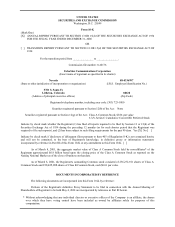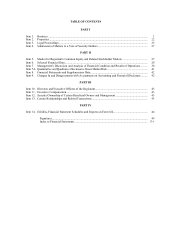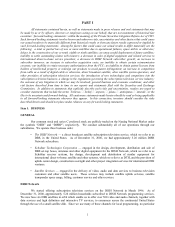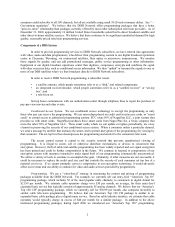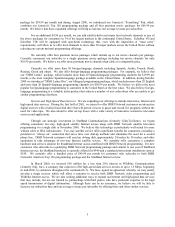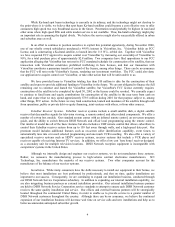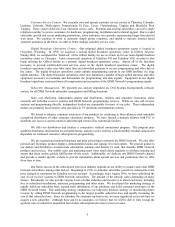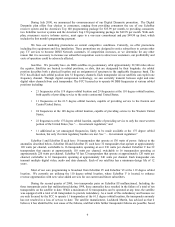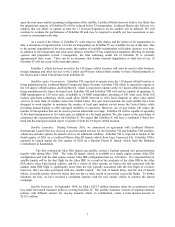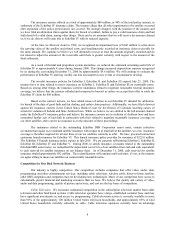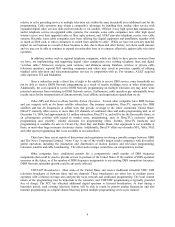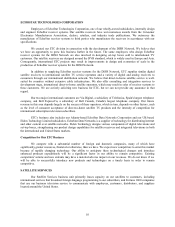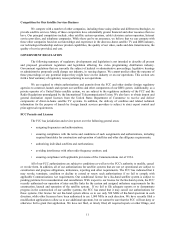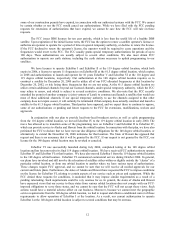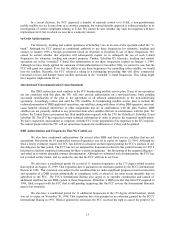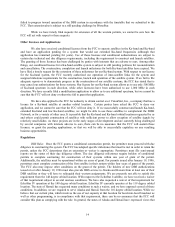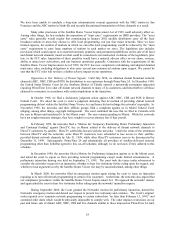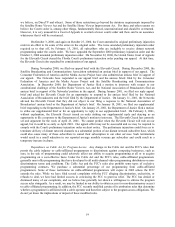Dish Network 2000 Annual Report Download - page 11
Download and view the complete annual report
Please find page 11 of the 2000 Dish Network annual report below. You can navigate through the pages in the report by either clicking on the pages listed below, or by using the keyword search tool below to find specific information within the annual report.9
relative to us by providing service to multiple television sets within the same household at no additional cost for the
programming. Cable operators may obtain a competitive advantage by bundling their analog video service with
expanded digital video services delivered terrestrially or via satellite, efficient 2-way high speed data transmission,
and/or telephone service on upgraded cable systems. For example, some cable companies now offer high speed
Internet access over their upgraded cable or fiber optic systems, and AT&T provides telephone service over cable
systems. Recently, some cable companies have been offering free digital equipment and installation, together with
as much as $500 cash, to entice consumers to switch from satellite to cable. While we have not seen any material
impact on our business as a result of these bounties to date, due to these and other factors, our churn could increase
and we may not be able to continue to expand our subscriber base or to compete effectively against cable television
operators.
In addition, entities such as regional telephone companies, which are likely to have greater resources than
we have, are implementing and supporting digital video compression over existing telephone lines and digital
“wireless cable.” Moreover, mergers, joint ventures, and alliances among franchise, wireless or private cable
television operators, regional Bell operating companies and others may result in providers capable of offering
bundled cable television and telecommunications services in competition with us. For instance, AT&T acquired
cable operators TCI and MediaOne.
Since a subscriber needs a direct line of sight to the satellite to receive DBS service, some households are
not be able to receive DISH Network programming as a result of nearby buildings, trees or other obstructions.
Additionally, the cost required to receive DISH Network programming on multiple television sets may deter some
potential customers from switching to DISH Network service. Furthermore, cable operators pay substantially lower
royalty rates for the retransmission of distant network, local affiliate and superstation signals than we do.
Other DBS and Direct-to-Home Satellite System Operators. Several other companies have DBS licenses
and can compete with us for home satellite subscribers. Our primary competitor, DirecTV, operates five DBS
satellites and has 46 frequencies at orbital slots that provide coverage to the entire continental United States.
DirecTV currently offers access to more than 225 channels of combined video and audio programming and, as of
December 31, 2000, had approximately 9.5 million subscribers. DirecTV is, and will be for the foreseeable future, in
an advantageous position with regard to market entry, programming, such as DirecTV’s exclusive sports
programming and, possibly, volume discounts for programming offers. Further, DirecTV hardware and
programming is available for sale in Circuit City, Best Buy and Radio Shack. Our equipment is not available at
these, or most other large consumer electronics chains. Additionally, DirecTV offers out of market NFL, NBA, NHL
and other sports programming that is not available to our subscribers.
There have been recent reports of discussions and negotiations involving a possible merger between GMH
and The News Corporation Limited. News Corp. is one of the world’s largest media companies with diversified
global operations including the production and distribution of motion pictures and television programming;
television, satellite and cable broadcasting. The effect such a merger would have on competition is unclear.
Other companies have conditional permits for a comparatively small number of DBS frequency
assignments that could be used to provide service to portions of the United States. If the number of DBS operators
increases in the future, or if the number of DBS frequency assignments to our existing DBS competitors increases,
DISH Network subscriber growth could be adversely affected.
VHF/UHF Broadcasters. Most areas of the United States can receive traditional terrestrial VHF/ UHF
television broadcasts of between three and ten channels. These broadcasters are often low to medium power
operators with a limited coverage area and provide local, network and syndicated programming. The local content
nature of the programming may be important to the consumer, and VHF/UHF programming is typically provided
free of charge. The FCC has allocated additional digital spectrum to licensed broadcasters. At least during a
transition period, each existing television station will be able to retain its present analog frequencies and also
transmit programming on a digital channel that may permit multiple programming services per channel.

